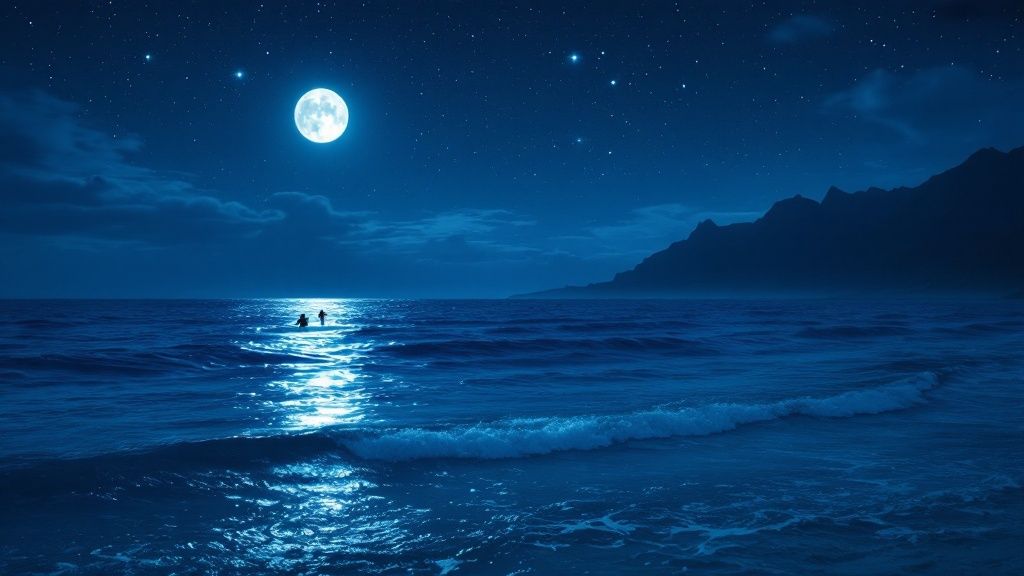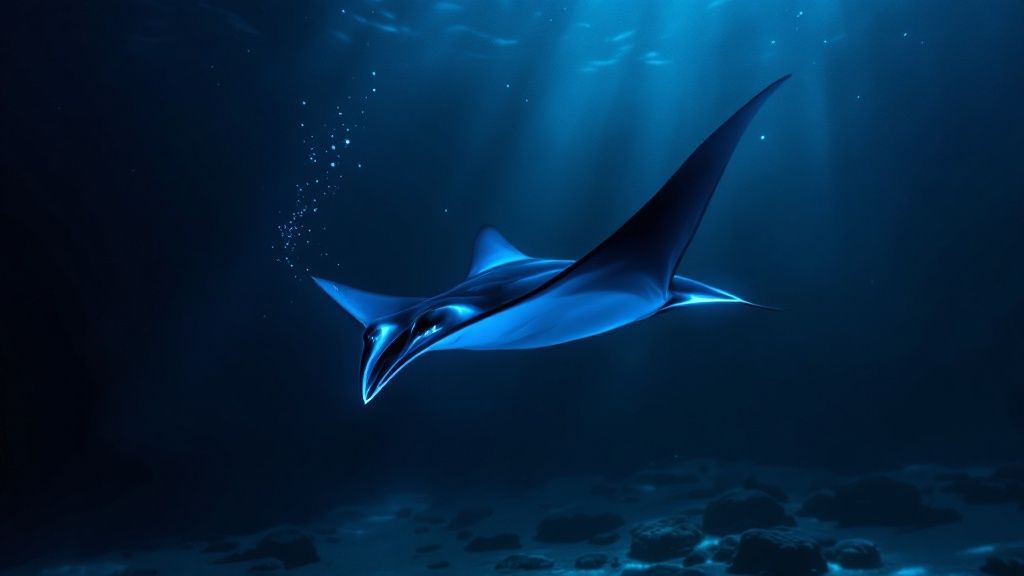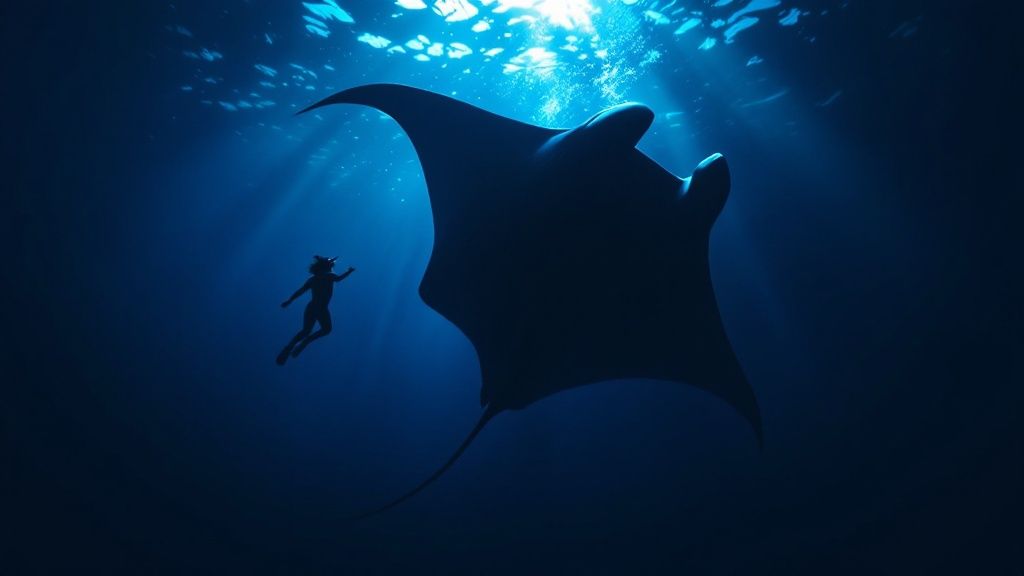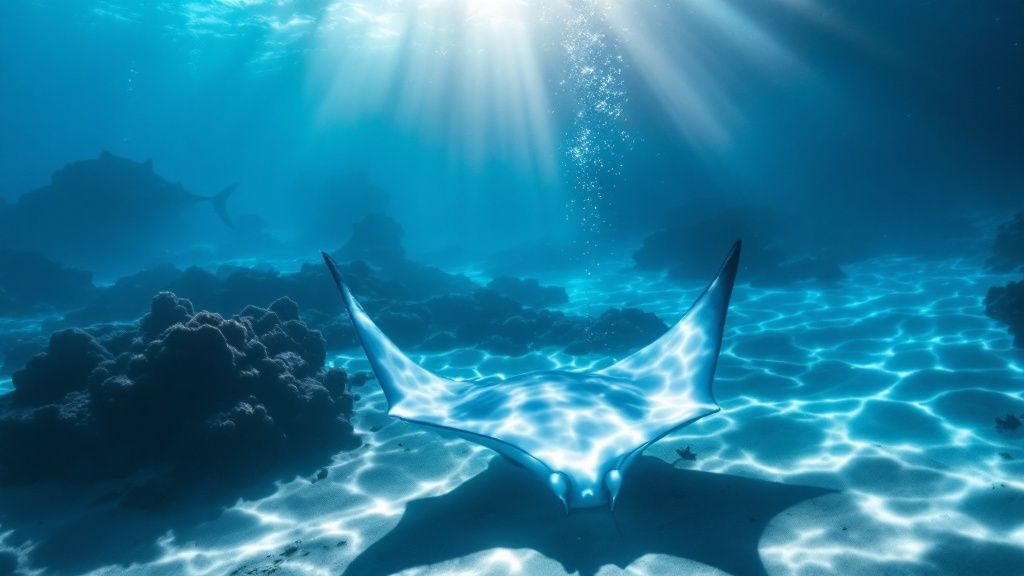The Magic of Manta Ray Night Snorkeling in Kona

Imagine floating beneath the stars, the dark ocean enveloping you. As night descends upon the Kona coast, an incredible underwater world comes alive. This is the setting for manta ray night snorkeling in Kona, a truly unforgettable experience. The Kona coast offers the ideal habitat for these graceful creatures, providing a natural stage for their mesmerizing movements under the moonlight.
Why Kona is a Manta Ray Hotspot
Several key factors combine to create this magical experience. Nutrient-rich ocean currents bring an abundance of plankton to the area. Plankton is the manta ray’s main food source. Attracted to the surface lights, this plankton forms a “plankton soup,” drawing the manta rays in.
The underwater landscape further enhances this natural feeding ground. Rock formations and specific current patterns concentrate the plankton, creating ideal dining spots for the mantas. Shallow bays like Makako Bay and Keauhou Bay are particularly popular with these gentle giants. This reliable food source combined with the warm, clear waters makes Kona a world-renowned manta ray hotspot. For more details on what to expect, check out Kona Honu Divers’ resource on Manta Ray Night Snorkeling.
Hawaii draws over 80,000 participants annually for this unique encounter, thanks in part to its thriving ecosystem. The experience allows snorkelers to observe the manta rays’ captivating feeding rituals, often described as an underwater ballet. Learn more about manta ray night snorkeling in Hawaii. You can also find additional information about Manta Ray Night Snorkel trips with Kona Honu Divers.
A Transformative Encounter
What sets manta ray night snorkeling apart from other wildlife encounters is the deep connection you form with these gentle giants. Some manta rays have wingspans of up to 12 feet. Watching these majestic creatures gracefully perform underwater acrobatics just inches below you is genuinely awe-inspiring. This close proximity, combined with the unique nighttime setting, creates a sense of wonder and profound respect for these animals.
This encounter often inspires a lifelong appreciation for the ocean and its inhabitants. It highlights the vital importance of conservation and the delicate balance within marine ecosystems. This special interaction resonates long after you leave the water. For a comprehensive look at available options, consider other providers like Manta Ray Night Snorkel Hawaii and Kona Snorkel Trips. Also, don’t forget to check out Captain Cook Snorkeling Tours.
Selecting Your Perfect Manta Ray Experience

Not all manta ray night snorkel tours in Kona are the same. Choosing the right tour operator can make all the difference in your experience. It’s about understanding what separates the exceptional tours from the rest. Smart travelers know to focus on key aspects that create an unforgettable and responsible wildlife encounter.
Key Considerations For Choosing a Tour
Smaller groups often lead to a more personalized experience. This allows for more interaction with the guides and less crowding while viewing the manta rays. High-quality wetsuits and snorkel gear can greatly enhance your comfort and enjoyment in the water. Perhaps the most important factor is the experience and knowledge of your guides. Knowledgeable guides can locate the manta rays and also offer valuable insights into their behavior and the surrounding ecosystem.
Beyond the basics, look for operators who prioritize safety protocols and have certified professionals on board. A marine biologist can add another layer of depth to your understanding of these incredible animals. Tours that support conservation initiatives ensure your money contributes to protecting these magnificent creatures. Finally, ask about their manta ray spotting strategies. Operators using real-time information and having established relationships with local spotters tend to have higher success rates. You might be interested in learning about the best time of year to see manta rays in Kona.
Recommended Manta Ray Snorkel Tour Operators
To help you choose, we’ve highlighted a few reputable tour operators in Kona that consistently provide exceptional manta ray night snorkel experiences. Each has been selected for their commitment to both guest satisfaction and ethical wildlife practices.
To make your decision even easier, we’ve compiled a comparison table outlining the key features of each tour operator.
To help you pick the perfect tour, we’ve created a comparison table highlighting the key features of each operator:
Comparison of Top Manta Ray Night Snorkel Tours
This table compares key features of leading manta ray snorkeling tour operators in Kona.
| Tour Company | Price Range | Group Size | Duration | Departure Location | Amenities |
|---|---|---|---|---|---|
| Kona Honu Divers | $100-$150 | 6-12 | 2-3 hours | Honokohau Harbor | Wetsuits, snorkel gear, snacks, drinks |
| Manta Ray Night Snorkel Hawaii | $120-$180 | 8-16 | 2.5-3.5 hours | Keauhou Bay | Wetsuits, snorkel gear, hot chocolate, cookies |
| Kona Snorkel Trips | $90-$140 | 10-20 | 2-3 hours | Honokohau Harbor | Wetsuits, snorkel gear, reef-safe sunscreen |
| Captain Cook Snorkeling Tours | $110-$160 | 12-24 | 3-4 hours | Keauhou Bay | Wetsuits, snorkel gear, light refreshments |
As you can see, each tour offers a slightly different experience, catering to various budgets and group preferences. Consider what’s most important to you, whether it’s small group sizes or specific amenities, to choose the best fit for your manta ray adventure.
By carefully considering these factors and selecting a reputable operator like Kona Honu Divers, Manta Ray Night Snorkel Hawaii, Kona Snorkel Trips, or Captain Cook Snorkeling Tours, you can ensure a truly memorable and impactful manta ray night snorkel experience in Kona.
Your Night Snorkel Journey: What Really Happens

Beyond the glossy brochures, what’s a manta ray night snorkel in Kona really like? This section takes you behind the scenes, offering a glimpse into the actual experience, from land to the underwater world. We’ll follow the process used by the experienced guides at Kona Snorkel Trips.
From Shore to Sea: A Carefully Orchestrated Experience
The journey begins with a boat trip from the shore to specific manta ray viewing areas. En route, guides typically brief you on safety procedures and the fascinating world of manta ray biology. This ensures you’re well-informed and prepared for the encounter. Once at the viewing site, specialized lights are placed in the water to attract plankton, creating a “plankton soup.” This is crucial, as the plankton attracts the manta rays for their evening meal.
The Manta Ballet: Up Close and Personal
You’ll then enter the water, usually near a floating platform with lights. These platforms provide stability and excellent viewing positions. You can hold onto the platform while floating, positioning yourself for the best view of the “manta ballet.” From here, you’ll witness these gentle giants gracefully looping and swooping through the illuminated water.
One of the most impressive aspects of manta ray night snorkeling in Kona is the high sighting success rate. Operators report seeing manta rays on roughly 85-90% of their night snorkeling trips. This consistency is due to the unique underwater landscape of the Kona Coast, which provides a reliable food source for the manta rays. Discover more insights about manta ray sightings. The clear, calm waters of Kona also improve visibility and safety. This high success rate contributes to the popularity of manta ray night snorkeling in Kona. You might also be interested in learning more about our Manta Ray night dive option.
Addressing Common Concerns: Safety and Comfort
Many first-time snorkelers have questions about night snorkeling. Rest assured, experienced guides take extensive safety and comfort precautions. They use acoustic and visual signals to enhance your experience and ensure everyone’s safety. The water temperature is generally comfortable, and the manta rays, despite their size, are harmless to humans. This allows you to relax and fully enjoy this magical encounter. Many operators also offer wetsuits for added comfort, further enhancing the experience.
Prime Locations: Where Manta Magic Happens

When planning a manta ray night snorkel adventure in Kona, choosing the right location is essential. Each site offers a unique experience, influenced by its distinct characteristics. Understanding these nuances is key to finding the perfect spot for your unforgettable encounter. Let’s explore some of Kona’s best manta ray viewing locations, with insights from the experts at Kona Honu Divers.
Manta Village and Garden Eel Cove: The Famous Feeding Grounds
Manta Village and Garden Eel Cove, nestled along the Kona coast, are renowned for their exceptional manta ray viewing opportunities. But what makes these locations so special? The answer lies in the unique underwater topography and prevailing currents.
Submerged rock formations create natural channels that funnel plankton into concentrated areas, essentially acting as plankton traps. Experienced boat captains from Kona Honu Divers strategically position their vessels and utilize lights to further enhance the plankton density, creating an irresistible feast for the manta rays. This predictable food source makes these sites ideal for consistent manta ray sightings, allowing snorkelers to witness their graceful feeding rituals up close.
Exploring Lesser-Known Kona Snorkel Sites
While Manta Village and Garden Eel Cove are popular choices, Kona offers several lesser-known gems for those seeking a more intimate manta ray experience. These hidden spots often provide encounters away from the larger crowds, allowing for a more personal connection with these magnificent creatures.
However, locating these hidden havens requires local knowledge and an understanding of manta ray behavior. Manta ray feeding grounds can change seasonally, influenced by factors like water temperature and plankton concentrations. Working with local experts can significantly enhance your chances of discovering these unique locations.
The following table highlights key information about some of the prime manta ray viewing locations in Kona:
Manta Ray Viewing Locations in Kona
Key information about the primary manta ray snorkeling locations along the Kona coast
| Location Name | Known For | Average Depth | Typical # of Mantas | Best Time to Visit | Access Method |
|---|---|---|---|---|---|
| Manta Village | Consistent sightings, easy access | 10-20 feet | 10-20 | Year-round | Boat tour |
| Garden Eel Cove | Similar to Manta Village, slightly shallower | 8-15 feet | 5-15 | Year-round | Boat tour |
| Keauhou Bay | Calm waters, occasional sightings | 10-30 feet | 2-5 | Year-round | Boat tour, Kayak |
| Makako Bay | More secluded, potential for larger groups | 15-25 feet | Varies seasonally | Summer months | Boat tour, Kayak |
This table provides a general overview, but it’s crucial to remember that manta ray sightings are never guaranteed. Working with reputable tour operators like Manta Ray Night Snorkel Hawaii and Kona Snorkel Trips is crucial. These operators possess the local expertise and knowledge to maximize your chances of a successful manta ray encounter. Additionally, Captain Cook Snorkeling Tours can provide further insight into Kona’s diverse marine life. By choosing wisely, you can ensure a memorable and rewarding manta ray experience in the beautiful waters of Kona.
Beyond Tourism: Conservation Impact of Your Encounter
Your manta ray night snorkel in Kona isn’t just a memorable experience; it’s a direct contribution to ongoing manta ray conservation. Operators like Captain Cook Snorkeling Tours are actively involved in research, transforming your tour into a unique blend of tourism and scientific discovery. This integration allows visitors to play a part in preserving these gentle giants.
Photo Identification: Unlocking Manta Ray Mysteries
One of the most valuable tools in manta ray conservation is photo identification. Each manta ray has unique spot patterns on its underside, similar to a human fingerprint. By photographing these patterns, researchers can track individual mantas over time. It’s essentially a vast, ocean-wide manta ray census.
This data helps researchers track migration patterns, population size, and even individual manta ray behavior. It offers a glimpse into their lives that would otherwise be impossible to obtain.
This long-term monitoring has already provided significant insights. The manta ray night snorkeling in Kona has a rich history of data collection. Between 2009 and 2014, careful records of manta ray sightings yielded crucial information about their movements and health. This research has improved scientists’ ability to predict sighting likelihood and understand manta ray behavior within their habitat. Find more detailed statistics here.
Protecting Manta Rays: Hawaii’s Groundbreaking Policies
Hawaii has been a leader in manta ray protection. The state has implemented policies restricting harmful fishing practices, such as gill netting. Regulations also limit boat traffic and human interaction within key manta ray habitats.
These legislative measures safeguard these vulnerable animals and demonstrate a strong commitment to their long-term survival.
Funding the Future: How Tourism Dollars Drive Research
The revenue generated from manta ray night snorkel tours directly supports essential research and conservation programs. This creates a sustainable cycle where tourism funds the very initiatives that protect these magnificent creatures. It’s a powerful example of responsible ecotourism in action. You might be interested in: Why you should go on a manta ray dive in Kona. This funding allows scientists to continue their crucial work, monitoring populations, studying behavior, and advocating for stronger protections.
A Global Model for Marine Ecotourism
The Kona manta ray night snorkel has become a model for sustainable marine ecotourism around the world. By demonstrating the positive relationship between tourism, research, and conservation, Kona shows how responsible tourism can benefit both local economies and the preservation of fragile marine ecosystems. This approach is a win-win, providing benefits for both wildlife and local communities and serving as a blueprint for other regions looking to establish similar programs. Check out our other resources like Manta Ray Night Snorkel and Manta Ray Night Snorkel Hawaii. Don’t forget to explore other exceptional tour operators like Kona Snorkel Trips.
By joining a manta ray night snorkel tour in Kona, you’re becoming part of a larger effort. You’re contributing to a vital conservation initiative that helps ensure these graceful creatures will continue to thrive in our oceans for future generations.
Insider Techniques for an Extraordinary Encounter
Want to make your manta ray night snorkel in Kona truly special? This section, drawing on the expertise of guides at Manta Ray Night Snorkel Hawaii, offers insider tips for an unforgettable experience. These simple techniques will enhance your comfort and maximize your manta ray viewing opportunities.
Mastering the Manta Ray Viewing Position
Finding the right position in the water is key. A good floating posture helps conserve your energy so you can fully appreciate the manta rays’ elegant movements. Guides recommend a relaxed, horizontal position, keeping your fins still to avoid disturbing the water.
This helps you blend seamlessly into the background, encouraging the manta rays to approach naturally. A horizontal position also creates a smaller profile in the water. This lowers the risk of accidental contact with the mantas as they gracefully glide beneath you.
Breathing Techniques for Extended Observation
Controlled breathing is crucial for spending more time observing the manta rays underwater. Slow, deep breaths help conserve your air supply and maintain a sense of calm. This allows you to enjoy the manta rays’ presence longer before needing to resurface.
Practice these breathing exercises before your trip to become comfortable with the rhythm. Remember to exhale slowly and gently to avoid startling the manta rays.
Essential Gear Considerations
While tour operators provide standard snorkeling gear, a few extra items can significantly boost your comfort and enjoyment. A thin wetsuit liner provides additional warmth, particularly during extended snorkeling sessions.
If you’re prone to seasickness, wristbands or medication can be incredibly helpful. You might also find this helpful: How to make the most of your manta ray night dive experience at Kona’s underwater nightclub.
Capturing the Magic: Camera Settings for Low-Light Conditions
Underwater photography in low light presents unique challenges. To capture clear images of manta rays, adjust your camera settings accordingly. Increase your ISO to a higher value, such as 800 or 1600. However, be aware that higher ISO settings can introduce some noise into your images.
Select a wide aperture to let in as much light as possible. A red filter will help compensate for the blue light emitted by dive lights, restoring more natural colors to your photographs. Consider using a dive light with a red mode to minimize disturbance to the manta rays and observe their natural behaviors.
Understanding Manta Ray Behavior
Learning to interpret manta ray behavior can significantly enrich your overall experience. For instance, if a manta ray approaches you directly, it’s a sign of curiosity. Remain calm and avoid sudden movements.
Slow, deliberate movements demonstrate respect and can help build trust with these magnificent creatures. Be mindful of their feeding habits; do not disrupt their natural feeding patterns. Observing these gentle giants in their natural habitat is a privilege, and respecting their space ensures a positive encounter for everyone.
Ready for a magical encounter with manta rays in Kona? Book your snorkeling adventure with Kona Honu Divers today!
